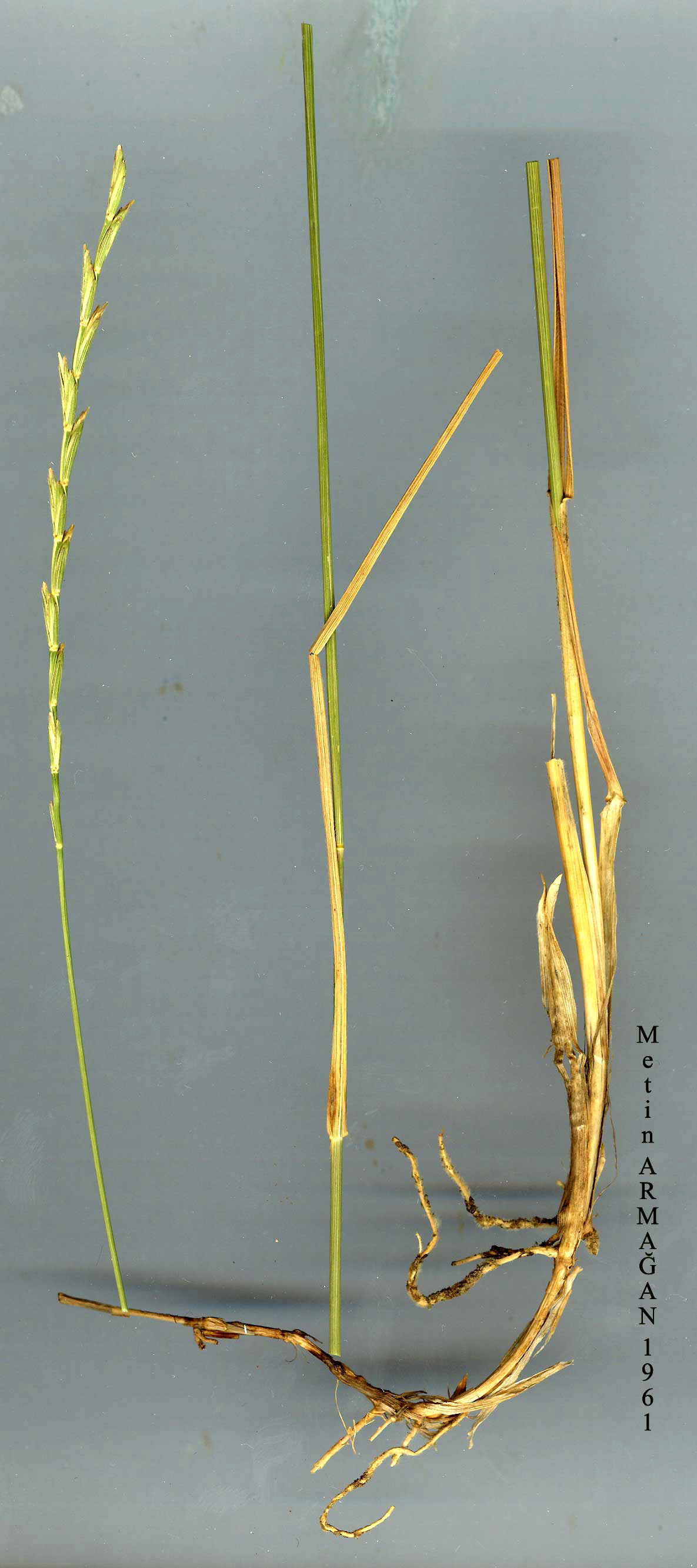| Poaceae |
|---|
Elymus hispidus (OPIZ) MELDERIS subsp. barbulatus (SCHUR) MELDERIS |
 Elymus hispidus (OPIZ) MELDERIS subsp. barbulatus (SCHUR) MELDERIS |
Elymus L.
|
E. hispidus (Opiz) Melderis in Bot. J. Linn. Soc. 76:380(1978). Perennial with often long-creeping rhizomes. Stems 40-80 cm, usually glabrous, sometimes densely and minutely pubescent on nodes. Leaves 2-6 mm broad, usually flat, glaucous-green, closely and rather prominently veined, with conspicuous marginal veins, scabrid, often also sparsely long-pilose on upper surface, usually glabrous beneath; sheaths usually long-ciliate. Spike 10-20 cm, erect, rather dense to lax; rachis spinulose-ciliate on main angles. Spikelets with 4-6 florets, compressed laterally. Glumes 5-8.5 mm, subequal, oblong or lanceolate-oblong, usually 5-veined, scabrid on keel towards apex, usually obtuse or obliquely truncate to truncate, with small triangular point or mucro at apex, sometimes subacute. Lemma 8-11 mm, keeled at apex, usually obtuse or mucronate. Palea ciliate on keels. 1. Spikelets glabrous subsp. hispidus 1. Spikelets pubescent 2. Glumes usually glabrous; lemmas ciliate along margins subsp. podpyerae 2. Glumes and lemmas ± densely pilose 3. Lemmas obtuse or mucronate subsp. barbulatus 3. Lemma With awn to 8 mm; glumes usually subacute subsp. pulcherrimus subsp. barbulatus (Schur) Melderis in Bot. J. Linn. S'oc. 76:381 (1978). Syn: Triticum trichophorum Link in Linnaea 17:395 (1843); Agropyron aucheri Boiss., Diagn. ser. 1(5):75 (1844)! A. barbulatum Schur in Verh. Siebenb. Ver. Naturw. 4:91 (1853) & Enum. Pl. Transs. 809(1866)! A. glaucum (Desf. ex DC.) Roemer & Schultes subsp. barbulatum (Schur) K. Richter, Pl. Eur. 1:124 (1890)! A. trichophorum (Link) K. Richter, op. cit. 124 (189O);A. intermedium (Host) P.Beauv. subsp. trichophorum (Link) Aschers.&Graebn., Syn. Fl. Mitteleur. 2:658 (l90l);Elytrigia trichophora (Link) Nevski in Acta Univ. Asiae Med. ser. 8b (Bot.) 17:61 (1934); Elytrigia intermedia (Host) Nevski subsp. trichophora (Link) Tzvelev in Novit. Syst. PL Vasc. (Leningrad) 10:31 (1973). Ic: Fl. Iraq 9: t. 75 (1968), as .4. trichophorum. Map 40. Fl. 6-8. Pinus nigra woods, limestone slopes with P. sylvestris and Juniperus, steppe, stony slopes, rocky hills, scree, dry banks, cornfields, 500-2895 m. Type: [Romania] Transylvania (iso. W!). Inner Anatolia. A3 Bolu: Abant G.,Wagenitz &Beug. A7 Gümüşane: Kirk-pauli, 16 vii 1894, Sint.! A8 Erzurum: Kop Da. pass, 2745 m, Furse 3780! A9Kars: d.Olty (Oltu), 'Awdostnij', 'Terpjank', Sosnowsky 14! B3 Eskişehir: Eskişehir, Warburg & Endlich 677! B4 Ankara: Ankara, 26 xii 1942, Birand! B5 Nevşehir: 20 km from Gülşehir to Kirşehir, 500m, McNeill 380! B6 Sivas: Sivas to Zara, Meydancik, 1500-1600 m, D. 68819! B7 Erzincan: Sipikör, Perinbaghre (Firinbahçe), Sint. 1890:3144! B8 Muş; 6 km S. of Varto, 1600 m, D. 46317! Varto, Goschkar, 1830 m, Kotschy 1859:356 (syntype of A. aucheriy. B9 Bitlis: Süphan Da., 2895 m, D. 24634! B10 Kars: mt. Ararat (Büyük Ağri Da.), S. ascent, 2500 m, Allen 57! C2 Antalya: Avlan G., vi-vii 1970, Quezel. C5 Içel: Gülek Boğaz 10 km N. of Tarsus, Bal. 1855:756 (syn-type of A. aucheri)\ C8 Mardin: Mardin, G. Post 40. C10 Hakkari: Samdi Da., 2130 m, Rix 207! C. Europe, Mediterranean area, S. Russia, Caucasia, Iraq, Iran, Afghanistan, C. Asia, W. Pakistan. Some specimens, e.g. A9 Erzurum: Horasan to Karaur-gan, 2000 m, D. 30726! A9 Kars: 8 km from Kars to Susuz, 1800 m, D. 30600! BlO Kars: 6 km S. from Iğdir to Doğubayazit, 1700 m, Kyoto Univ. Exped. 1970:7-8-2-A! have very hairy spikelets, leaves and sheaths and closely match the type of Agropyron aucheri Boiss., described from Iran (Pere Zend, Aucher 5424, G!), but within the area there also occur less hairy plants which approach European populations of subsp. barbulatus. A comparison of the holotype of A. aucheri, and syntypes from Turkey, with authentic material of A. barbulatum (W!) shows that they differ only in the degree of hairiness, which cannot be considered an essential diagnostic character. |